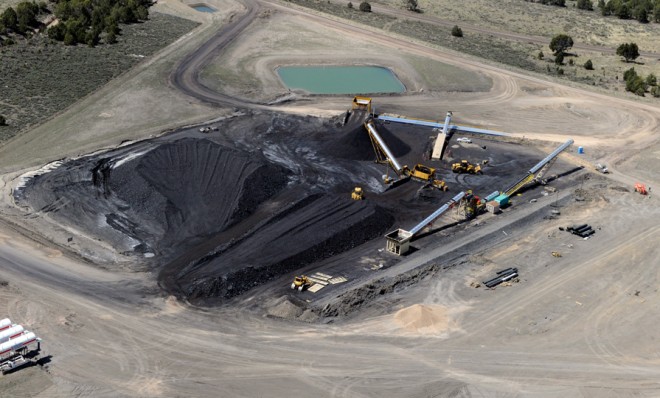The world's top 7 coal countries: By the numbers
Coal accounts for more than 40 percent of American electricity. But the U.S. still doesn't produce as much as China.

First off: What exactly is coal, and how does it work?
Basically, coal is a combustible sedimentary rock that's formed when organic material decays under pressure and heat for millions of years. The end product — which forms layers of black or dark brown rock composed of carbon, hydrogen, sulfur, oxygen, and nitrogen, is the leading source of electricity generation in the world. In America, coal is responsible for more than 40 percent of our electricity.
When used as a solid fuel, coal is mined, transported, cleaned, and pulverized, then burned in a large furnace. Water heated by the burning coal converts into steam, which spins turbines, which turn generators, which, of course, produce electricity.
The Week
Escape your echo chamber. Get the facts behind the news, plus analysis from multiple perspectives.

Sign up for The Week's Free Newsletters
From our morning news briefing to a weekly Good News Newsletter, get the best of The Week delivered directly to your inbox.
From our morning news briefing to a weekly Good News Newsletter, get the best of The Week delivered directly to your inbox.
How bad is coal for the environment?
Pretty bad. Per unit of electricity, coal produces more pollution than any other fuel source, according to the U.S. Environmental Protection Agency. Not only does it pollute the air with carbon dioxide, mercury compounds, sulfur dioxide, and nitrogen oxides, but coal production also releases methane, a compound with global warming potential at least 23 times greater than carbon dioxide, the EPA says.
And to access coal, miners sometimes use a controversial process called "mountain top removal," which is about as detrimental to mountain ecosystems as it sounds. What's more, water used in the coal refining process collects heavy metals like lead and arsenic, which can contaminate groundwater and nearby surface water.
So-called "clean coal" does provide hope for environmentalists. For instance, according to Fox News, Ohio State's Clean Coal Research Laboratory discovered a way to release heat from coal without burning it, "instead using iron-oxide pellets for an oxygen source and containing the reaction in a small, heated chamber from which pollutants cannot escape." The process, "coal-direct chemical looping," still releases waste in the form of water and coal ash, but none in the form of greenhouse gasses. It would be expensive to implement, but such technologies are promising for advocates of greener energy sources.
A free daily email with the biggest news stories of the day – and the best features from TheWeek.com
Well, if coal is so bad for the environment, why do we use it?
For most big coal-producing countries, the upsides are largely economic and political. The U.S., for one, houses more than one-fourth of the world's coal reserves. There's more energy potential in American coal than in all the world's known recoverable oil reservoirs combined. Having this much coal means a lot of jobs— there are 87,520 coal workers in the U.S., according to the Bureau of Labor Statistics — and less dependence on foreign oil.
But how does the U.S. compare to the rest of the world when it comes to coal? Here's a breakdown of the seven biggest coal countries, based on reserves.
The numbers, from 2011, are based on BP's Statistical Review of World Energy. It's worth noting that one million tons of coal would be enough to provide electricity to more than 190,000 customers annually.
1. USA
Reserves: 237,295 million tons
Percent of world total: 27.6
Annual production: 556.8 million tons of oil equivalent
Annual consumption: 501.9 million tons of oil equivalent
2. Russia
Reserves: 157,010 million tons
Percent of world total: 18.2
Annual production: 157.3 tons of oil equivalent
Annual consumption: 90.9 tons of oil equivalent
3. China:
Reserves: 114,500 million tons
Percent of world total: 13.3
Annual production: 1,956 million tons of oil equivalent
Annual consumption: 1,839.4 million tons of oil equivalent
4. Australia:
Reserves: 76,400 million tons
Percent of world total: 8.9
Annual production: 230.8 million tons of oil equivalent
Annual consumption: 49.8 million tons of oil equivalent
5. India
Reserves: 60,600 million tons
Percent of world total: 7
Annual production: 222.4 million tons of oil equivalent
Annual consumption: 295.6 million tons of oil equivalent
6. Germany
Reserves: 40,699 million tons
Percent of world total: 4.7
Annual production: 44.6 million tons of oil equivalent
Annual consumption: 77.6 million tons of oil equivalent
7. Ukraine
Reserves: 33,873 million tons
Percent of world total: 3.9
Annual production: 45.1 million tons of oil equivalent
Annual consumption: 42.4 million tons of oil equivalent
Carmel Lobello is the business editor at TheWeek.com. Previously, she was an editor at DeathandTaxesMag.com.
-
 Political cartoons for December 21
Political cartoons for December 21Cartoons Sunday’s political cartoons include Christmas movies, AI sermons, and more
-
 A luxury walking tour in Western Australia
A luxury walking tour in Western AustraliaThe Week Recommends Walk through an ‘ancient forest’ and listen to the ‘gentle hushing’ of the upper canopy
-
 What Nick Fuentes and the Groypers want
What Nick Fuentes and the Groypers wantThe Explainer White supremacism has a new face in the US: a clean-cut 27-year-old with a vast social media following